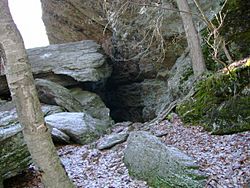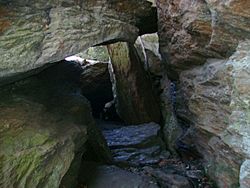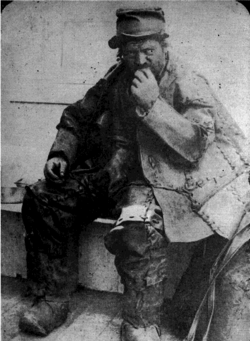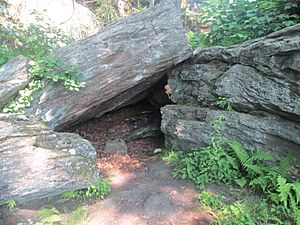Leatherman (vagabond) facts for kids
The Leatherman (c. 1839–1889 (aged 49–50) ) was a vagabond famous for his handmade leather suit of clothes who traveled through the northeastern United States on a regular circuit between the Connecticut River and the Hudson River from roughly 1857 to 1889. Of unknown origin, he was thought to be French-Canadian because of his fluency in the French language, his "broken English", and the French-language prayer book found on his person after his death. His identity remains unknown, and controversial. He walked a repeating 365-mile (587 km) route year after year, which took him through certain towns in western Connecticut and eastern New York, returning to each town every 34–36 days.
Life

Entrance to the Leatherman Cave in Watertown, Connecticut.
|
Living in rock shelters and "leatherman caves", as they are now locally known, the Leatherman stopped at towns along his 365-mile (587 km) loop about every five weeks for food and supplies. He was dubbed the "Leatherman" as his adornment of hat, scarf, clothes, and shoes were handmade from leather.
An early article in the Burlington Free Press dating to April 7, 1870, refers to him as the "Leather-Clad Man". It also states that he spoke rarely and when addressed would simply speak in monosyllables. According to contemporary rumors, he hailed from Picardy, France.
Fluent in French, he communicated mostly with grunts and gestures, rarely using his broken English. When asked about his background, he would abruptly end the conversation. Upon his death, a French prayer book was found among his possessions. He declined meat on Fridays, giving rise to speculation that he was Roman Catholic.
It is unknown how he earned money. One store kept a record of an order: "one loaf of bread, a can of sardines, one-pound of fancy crackers, a pie, two quarts of coffee, one gill of brandy and a bottle of beer"
The Leatherman was well known in Connecticut. He was reliable in his rounds, and people would have food ready for him, which he often ate on their doorsteps. Ten towns along the Leatherman's route passed ordinances exempting him from the state "tramp law" passed in 1879.
Health
The Leatherman survived blizzards and other foul weather by heating his rock shelters with fire. Indeed, while his face was reported to be frostbitten at times during the winter, by the time of his death he had not lost any fingers, unlike other tramps of the time and area.
The Connecticut Humane Society had him arrested and hospitalized in 1888, which resulted in a diagnosis of "sane except for an emotional affliction", after which he was released, as he had money and desired freedom. He ultimately died from cancer of the mouth due to tobacco use. His body was found on March 24, 1889, in his Saw Mill Woods cave on the farm of George Dell in the town of Mount Pleasant, New York, near Ossining.
Grave

Inside the Leatherman Cave in Watertown, Connecticut.
|
The Leatherman's grave is in the Sparta Cemetery, on Route 9 in Ossining, New York. The following inscription was carved on his original tombstone:
FINAL RESTING PLACE OF
Jules Bourglay
OF LYONS, FRANCE
"THE LEATHER MAN"
who regularly walked a 365-mile route
through Westchester and Connecticut from
the Connecticut River to the Hudson
living in caves in the years
1858–1889
The Leatherman's grave was subsequently moved further from Route 9. When the first grave was dug up, no traces were found of the Leatherman's remains, only some coffin nails, which were reburied in a new pine box, along with dirt from the old grave site. Nicholas Bellantoni, a University of Connecticut archaeologist and the supervisor of the excavation, cited time, the effect of traffic over the shallow original gravesite, and possible removal of graveside material by a road-grading project for the complete destruction of hard and soft tissue in the grave. The new tombstone, installed on May 25, 2011, simply reads "The Leatherman".
Exhumation and reburial
The Leatherman's original grave in Sparta Cemetery was within 16 feet (5 m) of Route 9. His remains were exhumed and were reburied at a different site in the cemetery on May 25, 2011. No visible remains were recovered during the exhumation. Rather, coffin nails and soil recovered from the original burial plot were reburied at the new site. Part of the reason for the exhumation process was to test his remains to determine his origins.
Towns visited
The Leatherman's circuit took in the following towns:
- Brewster, New York
- North Salem, New York
- Ridgefield, Connecticut
- Branchville, Connecticut
- Georgetown, Connecticut
- Redding, Connecticut
- Danbury, Connecticut
- Woodbury, Connecticut
- Watertown, Connecticut
- Thomaston, Connecticut
- Terryville, Connecticut
- Bridgewater, Connecticut
- Waterbury, Connecticut
- Bristol, Connecticut
- Forestville, Connecticut
- New Britain, Connecticut
- Berlin, Connecticut
- Old Saybrook, Connecticut
- Guilford, Connecticut
- Branford, Connecticut
- East Haven, Connecticut
- New Haven, Connecticut
- Bronxville, New York
- Stratford, Connecticut
- Bridgeport, Connecticut
- Trumbull, Connecticut
- Norwalk, Connecticut
- New Canaan, Connecticut
- Stamford, Connecticut
- Greenwich, Connecticut
- White Plains, New York
- Armonk, New York
- Chappaqua, New York
- Ossining, New York
- Sleepy Hollow, New York
- Mount Kisco, New York
- Bedford Hills, New York
- Pound Ridge, New York
- Yorktown, New York
- Peekskill, New York
- Somers, New York
- Derby, Connecticut
- Woodbridge, Connecticut
- Naugatuck, Connecticut
- Hamden, Connecticut
- Southington, Connecticut
- Burlington, Connecticut
- Middletown, Connecticut
- Meriden, Connecticut
- Portland, Connecticut
- Wilton, Connecticut
Popular media
- The Leatherman inspired a song by the American rock band Pearl Jam, "Leatherman". It was released as a B-side of the single "Given to Fly" from the 1998 album Yield.
- The song "Mennyt mies" by Finnish singer-songwriter J. Karjalainen makes a reference to "Uuden-Englannin nahkamies" ("New England Leatherman").
- Leatherman was the subject of a 1984 video documentary which was shown on Connecticut Public Television.
- In 1965, on his program Perception, Dick Bertel interviewed Mark Haber (1899–1994) about the Leatherman on Channel 3, WTIC-TV (WFSB since 1974) in Hartford, Connecticut.
See also
 In Spanish: Leatherman (vagabundo) para niños
In Spanish: Leatherman (vagabundo) para niños




